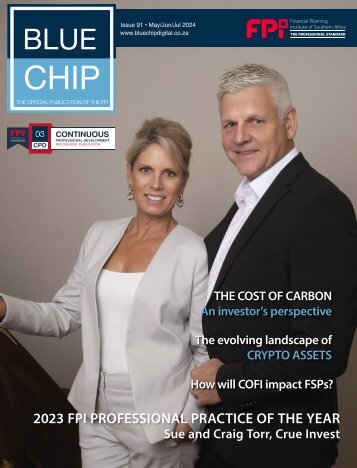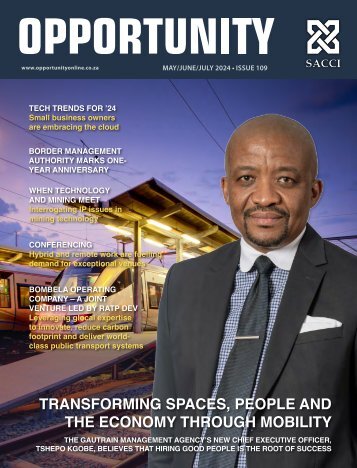South African Business 2016 edition
- Text
- Investment
- Government
- Business
- Development
- Network
- Sectors
- Investing
- Business
- Africa
- African
- Economic
- Manufacturing
- Mining
- Opportunities
- Economy
- Overview
FOCUS A Catalyst for
FOCUS A Catalyst for Economic Development Johannesburg’s Urban Development Zone Tax Incentive is driving Gauteng’s development. The City of Johannesburg’s Inner City has a highly developed economic infrastructure and is the second most productive of Joburg’s Regions, adding about 23% to the City’s economy, a share larger than some of South Africa’s metropolitan economies combined. It continually demonstrates its economic powerhouse status by the fact that it houses the headquarters of several powerful mining houses, fi nancial services and expanding multi-national corporations. It also boasts several high-rise sectional title apartments and condominiums. However, as has been the trend internationally with large cities, economic factors in the 1980s caused Joburg’s Inner City to experience urban deterioration. These factors threatened the ‘heartbeat’ of the city. “One should not think that such a state of affairs was unique to Johannesburg”, says Lebo Ramoreboli, Deputy Director responsible for the Johannesburg Urban Development Zone (UDZ). She says Cape Town and many other municipalities who experienced similar urban deterioration. In 2004, the South African government, at the cities’ request, introduced the innovative UDZ tax incentive to assist Municipalities to revitalise their derelict CBDs and thus reverse their urban decline. This helped them to create new opportunities for the improvement and development of lo- cal Central Business Districts (CBDs). “The UDZ tax incentive has enhanced Joburg’s attractiveness as a preferred destination for property-related investment for new as well as existing investors, and has encouraged corporate and other residents to remain and expand their foothold in the CBD. It has helped to drive our mandate to transform the Inner City into a vibrant and dynamic economic node that will attract everyone, including international investors,” says Ramoreboli. Already more than R13-billion worth of investment has come into the CBD. “This initiative is an important economic tool that has assisted the City to further create Park Station renderings. SOUTH AFRICAN BUSINESS 2016 166
an enabling environment for business in the property sector, hence the visible economic revitalisation that is taking place in the Inner City,” says Ruby Mathang, Member of Mayoral Committee (MMC) responsible for Economic Development. “Through this initiative we hope to encourage transformation of property ownership patterns that will involve large and small investors, black investors as well as women and the youth. We are looking forward to a city that is fundamentally different from the past, a city that embraces non-racialism, a city that embraces all cultures and religions, a cosmopolitan city that will attract not only South Africans but people from around the world.” MMC Mathang strongly emphasises the importance of the tax incentives: “The UDZ gives impetus for the other city departments to focus their efforts and spend on the areas such as those where the UDZ has attracted the renewal and developments seen thus far,” says Mathang. Live, Work and Play in the City Ravi Naidoo, the Executive Director for Economic Development under whom the Urban Development Zone tax incentive resides, expressed appreciation of the innovativeness of investors that has led to the creation of thematic precincts such as University City in Braamfontein (a whole-lifestyle precinct for students and emerging graduates). Other developments, such as those in Newtown, have been revived in the form of a combination of residential and retail spaces. This is in addition to the Zurich Building, Turbine Square precinct that comprises the headquarters of AngloGold Ashanti and The Forum, a unique conference centre. In Marshalltown, Ferreirasdorp, Doornfontein and part of Jeppestown attractive districts and streetscapes have been created such as Maboneng and Arts-on-Main, Fox Street, Ghandi Square and the Main Street precincts. “Expansion of the FNB’s Bank City has created an exemplary precinct comprised of the fi nancial services sector with signifi cant retail and offi ce space. It is one of the most attractive places in our City. It has continued to expand and attract investors into the node,” continues Naidoo. The idea is to rejuvenate the City of Johannesburg as a city where people can live, work and play by supporting the creation of several mixed-use precincts that attract a diverse range of investors, businesses, visitors and residents. Standard Bank continues to expand its Inner City premises, a further confi rmation of the FOCUS Future Mandela Park renderings. Inner City’s status as a fi nancial services’ hub. There is also a new trend that refl ects young investors’ appetite to purchase sectional title units. This is in accordance with our desire to lure young black professionals and women to come and invest in property within the various precincts of our Inner City and thus gradually diversify property ownership patterns,” adds Naidoo. The area adjoining the railroad that extends from Park Station to Fordsburg and from Park Station to Doornfontein is another potential area for new kinds of precincts in partnership with the private sector. Fordsburg can become a design centre to enhance activities that currently exist. Newtown is currently a cultural district, but has the potential to better align with academic activities due to its proximity to Wits University. There are also plans in place to commercialise Park Station as the biggest transit node in Africa by developing it to its prospected capacity, which is estimated to be 10 times the current size of Sandton City. “For the fi rst time, and as a result of the Gautrain roll-out, 167 SOUTH AFRICAN BUSINESS 2016
- Page 1:
SOUTH AFRICAN BUSINESS 2016 EDITION
- Page 6:
CONTENTS Introduction CONTENTS Sout
- Page 10 and 11:
CREDITS Publisher Chris Whales Publ
- Page 12 and 13:
SPECIAL FEATURE South Africa A peri
- Page 14 and 15:
SPECIAL FEATURE In a year that saw
- Page 16 and 17:
SPECIAL FEATURE owes its existence
- Page 18 and 19:
SPECIAL FEATURE against water losse
- Page 20 and 21:
SPECIAL FEATURE Operation Phakisa h
- Page 22 and 23:
SPECIAL FEATURE late in 2014. The h
- Page 24 and 25:
SPECIAL FEATURE Understanding Afric
- Page 26 and 27:
INTERVIEW Job creation on track Ala
- Page 28 and 29:
SPECIAL FEATURE Business funding Th
- Page 30 and 31:
SPECIAL FEATURE in turn makes it ve
- Page 32 and 33:
SPECIAL FEATURE Contact: 012 394 18
- Page 34 and 35:
SPECIAL FEATURE Black Business Supp
- Page 36 and 37:
SPECIAL FEATURE The evolution of sk
- Page 38:
SPECIAL FEATURE providing TVET lear
- Page 42:
PROFILE FP&M Seta Facilitating and
- Page 45 and 46:
• The development of a national s
- Page 48 and 49:
FOCUS Champions of change Five dyna
- Page 50 and 51:
SPECIAL FEATURE The top law firms S
- Page 52 and 53:
SPECIAL FEATURE Keeping the BRICS t
- Page 54 and 55:
SPECIAL FEATURE Keeping BEPS in che
- Page 56 and 57:
SPECIAL FEATURE IPAP in action In 2
- Page 58 and 59:
FOCUS THERE’S NO END TO THE BENEF
- Page 60 and 61:
INTERVIEW The riches of Africa awai
- Page 62 and 63:
INTERVIEW and it could actually be
- Page 64 and 65:
PROFILE ECIC exco profiles Profiles
- Page 66 and 67:
INTERVIEW The hub of Africa Tim Har
- Page 69 and 70:
Key sectors Overview of the main ec
- Page 71 and 72:
OVERVIEW from the subsistence farme
- Page 73 and 74:
OVERVIEW South Africa produces abou
- Page 75 and 76:
South Africa’s looming energy gap
- Page 77 and 78:
How will these resources be develop
- Page 79 and 80:
Vall exclusive economic zone limits
- Page 82 and 83:
OVERVIEW NEED PIC Mining The South
- Page 84 and 85:
OVERVIEW Mineral beneficiation The
- Page 86 and 87:
PROFILE The Council for Geoscience
- Page 88 and 89:
OVERVIEW Energy The South African e
- Page 90 and 91:
INTERVIEW Cummins South Africa Cumm
- Page 92 and 93:
OVERVIEW Manufacturing Increasing m
- Page 94 and 95:
OVERVIEW Automotive International i
- Page 96 and 97:
OVERVIEW Automotive components Incu
- Page 98 and 99:
OVERVIEW Chemicals and pharmaceutic
- Page 100 and 101:
OVERVIEW Healthcare South Africa’
- Page 102 and 103:
OVERVIEW Water Severe water restric
- Page 104:
OVERVIEW Improving quality The intr
- Page 107 and 108:
Our Vision is is “Quality water f
- Page 109 and 110:
OVERVIEW 107 SOUTH AFRICAN BUSINESS
- Page 111 and 112:
OVERVIEW airports in India and Braz
- Page 113 and 114:
affords, while maintaining its envi
- Page 115 and 116:
kets, except Australia. In Africa,
- Page 117 and 118: Rosebank, Johannesburg, renamed ‘
- Page 119 and 120: Trade with Africa Improved infrastr
- Page 121 and 122: FOCUS MTN plugs R1.2-billion into K
- Page 123 and 124: MTN rolls out fibre infrastructure
- Page 125 and 126: OVERVIEW community engagement. The
- Page 127 and 128: PROFILE For BEE Verification and is
- Page 129 and 130: OVERVIEW attracting and retaining c
- Page 131 and 132: OVERVIEW Small business is taken ve
- Page 133 and 134: Franchise Fund—an innovative plat
- Page 135 and 136: educating young people in fields th
- Page 137 and 138: OVERVIEW Management Plan has divert
- Page 139 and 140: hazardous waste is also not being c
- Page 141 and 142: INTERVIEW yourself up as a Tier 1 o
- Page 144 and 145: OVERVIEW Renewable energy South Afr
- Page 146 and 147: INTERVIEW Plenty of scope for solar
- Page 148 and 149: LISTINGS South African business org
- Page 150 and 151: LISTINGS South African National Gov
- Page 152 and 153: LISTINGS Department of Communicatio
- Page 154 and 155: LISTINGS Department of Human Settle
- Page 156 and 157: LISTINGS Department of Science and
- Page 158 and 159: OVERVIEW Regional overview: Eastern
- Page 162 and 163: INTERVIEW Buffalo City on the rise
- Page 164 and 165: OVERVIEW Regional overview: Free St
- Page 166 and 167: OVERVIEW Regional overview: Gauteng
- Page 170 and 171: FOCUS business people and tourists
- Page 172 and 173: OVERVIEW Regional overview: KwaZulu
- Page 174 and 175: OVERVIEW Regional overview: Limpopo
- Page 176 and 177: OVERVIEW Regional overview: Mpumala
- Page 178 and 179: The powerhouse of Africa Mpumalanga
- Page 180 and 181: Mpumalanga: Key Sectors Mpumalanga
- Page 182 and 183: Nkomazi Special Economic Zone The N
- Page 184 and 185: INVEST IN THE PROVINCE OF THE RISIN
- Page 186 and 187: OVERVIEW Regional overview: Norther
- Page 188 and 189: OVERVIEW Regional overview: North W
- Page 190 and 191: OVERVIEW Regional overview: Western
- Page 192 and 193: FOCUS Khayelitsha - the power of to
- Page 194 and 195: INDEX INDEX Abeco Tanks ...........
- Page 196: ENSafrica.com ENSafrica | Africa’
Inappropriate
Loading...
Mail this publication
Loading...
Embed
Loading...






















































































































































